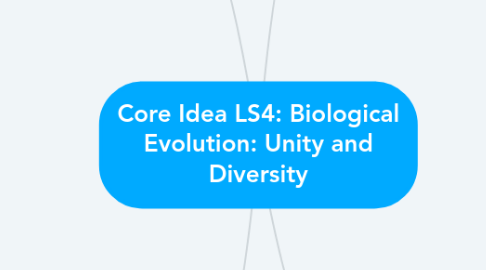
1. LS4.C: Adaptation
1.1. Environmental Changes
1.1.1. Morphological, Physiological, or Behavioral traits of species
1.1.1.1. Changes the distribution of traits in the population
1.1.1.1.1. Organisms that are better suited for their environment
1.2. Grade Band Endpoints for LS4.C
1.2.1. Students will know by the end of grade 2
1.2.1.1. Living organisms survive in environments where their needs are met. When the environment is too hot or too cold or have too little water or food, plants and animals may not be able to survive.
1.2.2. Students will know by the end of grade 5
1.2.2.1. Changes in an organism’s habitat are sometimes beneficial to it and sometimes harmful. The environment determines if the organisms will survive well, survive adequately, or die out.
1.2.3. Students will know by the end of grade 8
1.2.3.1. Adaptation
1.2.3.1.1. Natural selection: process by which species change over time in response to changes in environmental conditions.
2. LS4.D: Biodiversity and Humans
2.1. Human beings
2.1.1. Are part of and depend on the natural world.
2.2. Biodiversity
2.2.1. Genes, species, and ecosystems
2.2.1.1. Renewable resources, such as food, medicines, and clean water
2.3. Ecosystem services
2.3.1. Climate stabilization, decomposition of wastes, and pollination that are provided by healthy ecosystems
2.3.2. Negative affects of humans
2.3.2.1. Resources used unsustainable limits: habitat destruction, pollution of air and water, overexploitation of resources, introduction of invasive species, and climate change
2.4. Grade Band Endpoints for LS4.D
2.4.1. Students will know by the end of grade 2.
2.4.1.1. There are a variety of living organisms in an environment, and they exist in different places on land and in water.
2.4.2. Students will know by the end of grade 5.
2.4.2.1. Scientists have identified and classified many plants and animals.
2.4.2.1.1. Living organisms live in a variety of habitats, and changes in those habitats affects the organisms living there.
2.4.3. Students will know by the end of grade 8.
2.4.3.1. Biodiversity is the adaption of living organisms to the diverse conditions on Earth. Terrestrial and marine ecosystems.
2.4.3.1.1. Genetic variation within a species, in different habitats and ecosystem types (e.g., forests, grasslands, wetlands).
3. LS4.A: Evidence of Common Ancestry and Diversity
3.1. Extensive Scientific Evidence: The fossil record to genetic relationships among species
3.2. Grade Band Endpoints for LS4.A
3.3. Students will know by the end of grade 2.
3.3.1. A selected amount of plants and animals are extinct on the Earth. Some modern animals resemble and have similar traits of extinct animals.
3.4. Students will know by the end of grade 5.
3.4.1. Fossils, Visible and Microscopic, reveal information about organisms and the details of their environments.
3.4.1.1. Fossils can be compared with other fossils. They can also be compared to living organisms according to their similarities and differences.
3.5. Students will know by the end of grade 8.
3.5.1. Fossils: mineral replacements, preserved remains, or traces of organisms that lived in the past
3.5.2. Sedimentary rock layers provide evidence of the history of Earth. It also demonstrates the changes in organisms from the fossil remains found in the layers.
3.5.2.1. Fossil Record
3.5.2.1.1. Radioactive dating
3.5.2.1.2. the existence, diversity, extension, and the change of many life forms throughout history of life on the Earth.
3.5.3. Similarities and differences of organisms living today and the organisms in the fossil record enable the reconstruction of evolutionary history and evolutionary descent.
4. LS4.B: Natural Selection
4.1. Genetic variation
4.1.1. Survival and Reproduction
4.1.1.1. Results in individuals with a range of traits
4.1.2. Natural Selection
4.1.2.1. Individuals with particular traits may be more likely than others to survive and produce offspring
4.1.2.2. Predominance of certain inherited traits in a population and the suppression of others
4.2. Grade Band Endpoints for LS4.B
4.2.1. Students will know by the end of grade 2.
4.2.1.1. [Intentionally left blank.]
4.2.2. Students will know by the end of grade 5.
4.2.2.1. The variations of characteristics between individuals of the same species may provide advantages in surviving, finding mates, and reproducing.
4.2.3. Students will know by the end of grade 8.
4.2.3.1. Natural selection
4.2.3.1.1. Predominance of certain traits in a population and the suppression of others
4.2.3.2. Artificial selection
4.2.3.2.1. Humans have influenced certain characteristics of organisms by selective breeding. Parental traits determined by genes, which are then passed on to offspring.
